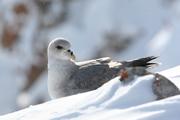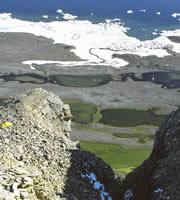 Foul waters: Canadian arctic lakes can be polluted by bird droppings.© Mark Mallory
Foul waters: Canadian arctic lakes can be polluted by bird droppings.© Mark MalloryPollution is swept to pristine areas of the Arctic by wind and sea. But now researchers have pinned down an important mode of transport that creates local toxic hotspots: sea birds.
Canadian researchers have found that lakes in the Arctic that are frequented by northern fulmars (Fulmarus glacialis) can harbour 10-60 times more pollutants than neighbouring, birdless lakes. These pollutants include persistent, toxic compounds such as mercury, DDT and hexachlorobenzene (HCB), which were once common ingredients in pesticides and fungicides.
Jules Blais of the University of Ottawa, Ontario, and colleagues looked at freshwater ponds that sit below the cliffs at Cape Vera on northern Devon Island in the Canadian Arctic. During the summer months, these cliffs harbour the nests of about 20,000 of the migratory fulmars. Pollutants enter the ponds through the birds' excrement, the researchers say.
The key to the study was finding an area with several lakes that differed only in the number of birds living above them. By comparing 11 lakes that hosted different bird colonies, the researchers weeded out exactly how much impact the birds and their guano have on the environment. In some of the more contaminated lakes, they found that mercury concentrations approach or exceed the Canadian guidelines for protecting wildlife, Blais says. They report their results in Science1.
Up the food chain
 Fulmars can accumulate toxins from the fish and squid they eat.© Mark Mallory
Fulmars can accumulate toxins from the fish and squid they eat.© Mark MalloryChemicals such as HCB, DDT and the coolants known as polychlorinated biphenyls (PCBs) are very stable and tend to accumulate in the fatty tissue of animals that eat contaminated prey. The fulmars pick up such contaminants from squid, fish and carrion. The birds do not seem to suffer, the researchers say, but they pass on the poisons to predators higher up the food chain.
Indigenous people in the area are known to eat animals that are highly contaminated. Preliminary studies show that mercury and PCBs can cause immune system dysfunction, adverse neurological effects and IQ deficits.
Other researchers, including Anita Evenset of the Polar Environmental Centre in Tromsø, Norway, have also seen hints that migratory birds are bringing toxins to the Norwegian Arctic, but it has been hard to quantify the effect in the past. Together, the Norwegian and Canadian studies emphasize the importance of this mechanism of toxin transport.
ADVERTISEMENT
Although wind and sea currents continue to be a major source of pollution to the Arctic as a whole, Blais says, his work emphasizes that some locations can gather a much higher level of pollution than others thanks to migratory animals. Such hotspots should be accounted for in monitoring efforts, he says. But the best way to counter the problem, he adds, is simply to prevent these chemicals from entering the environment in the first place.
